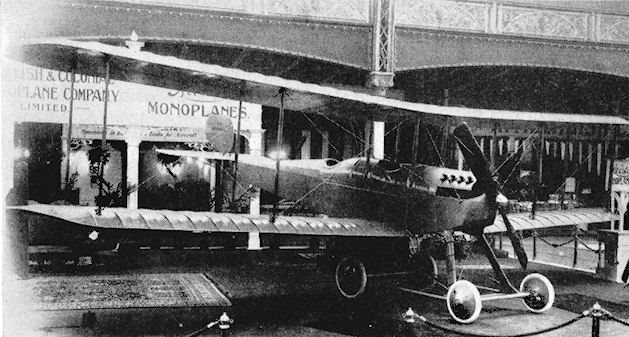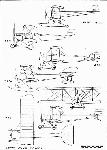
Описание
Страна: Великобритания
Год: 1913
Варианты
- Bristol - BR.7 - 1913 - Великобритания
- Bristol - TB.8 / GB.75 - 1913 - Великобритания
- C.Barnes Bristol Aircraft since 1910 (Putnam)
- H.King Armament of British Aircraft (Putnam)
- M.Goodall, A.Tagg British Aircraft before the Great War (Schiffer)
- P.Lewis British Aircraft 1809-1914 (Putnam)
- Журнал Flight
-
P.Lewis - British Aircraft 1809-1914 /Putnam/
Bristol Coanda B.R.7 at 1913 Olympia Aero Show.
-
M.Goodall, A.Tagg - British Aircraft before the Great War /Schiffer/
Bristol Coanda Type BR7 of 1913 for the Spanish government. Works No.157.
-
C.Barnes - Bristol Aircraft since 1910 /Putnam/
Pixton flying B.R.7 No. 157 at Larkhill, 1913.
-
Журнал - Flight за 1913 г.
AT OLYMPIA SHOW. - The 70.h.p. Bristol biplane, as seen from the side.
-
Журнал - Flight за 1913 г.
The new 70-h.p. Bristol biplane, one of the features of the Olympia Show.
-
Журнал - Flight за 1913 г.
Lieut. Roger Marshall, R.F.A. (Reserve), another pupil who passed his brevet tests at the Bristol, Lark Hill, School, in a 15-m.p.h. wind.
-
Журнал - Flight за 1913 г.
A school group at the Bristol Flying School, Amesbury, Wilts., showing just a few pupils grouped round one of the two-seater biplanes. Reading from left to right: Mr. Jullerot, pilot; Mr. David Tod, pupil, who is flying the monoplane excellently; Lieut. Marshall, pupil; Lieut. Chidson, pupil; Mr. C. H. Platon; Herr Paschen, a pilot of the German Bristol School; Mr. Fellows, of the Bristol Co.; Mr. Harrison, pilot; and Lieut Bromet, R.N., pupil.
-
Журнал - Flight за 1913 г.
The 70-h.p. Renault-Bristol biplane.
-
Журнал - Flight за 1913 г.
Другие самолёты на фотографии: Bleriot Bleriot-XI-2 - Франция - 1911Breguet 3 - Франция - 1910Bristol Coanda monoplane - Великобритания - 1912Caudron C / D / E - Франция - 1912Caudron N - Франция - 1911Cody No.5 - Великобритания - 1912Deperdussin hydro-monoplane - Франция - 1912Deperdussin Racer - Франция - 1912Farman HF.15/16/20 - Франция - 1912Maurice Farman MF.7 Longhorn - Франция - 1912RAF B.E.2/B.E.2a/B.E.2b - Великобритания - 1912
-
Журнал - Flight за 1916 г.
Mounting and housing of Vee-type air-cooled engines. Inset in centre, the Renault engine, showing tubular bearers.
Другие самолёты на фотографии: Flanders F4 - Великобритания - 1912Maurice Farman MF.11 Shorthorn - Франция - 1913RAF B.E.2/B.E.2a/B.E.2b - Великобритания - 1912
-
P.Lewis - British Aircraft 1809-1914 /Putnam/
Bristol B.R.7
-
Jane's All The World Aircraft 1913 /Jane's/
70 h.p. biplane.
C.Barnes Bristol Aircraft since 1910 (Putnam)
The Bristol-Coanda Two-seat Biplanes
When the flying of monoplanes by pilots of the Military Wing, Royal Flying Corps, was banned in September 1912, the loss of the potential War Office market for the Coanda monoplane was partly mitigated by the award of a contract to build the officially designed B.E.2 biplane, which, although ineligible for the Military Aeroplane Competition, had performed rather better than the actual prizewinners. The fact that a biplane could match the monoplane's performance without sacrificing its advantages of strength and stiffness led Coanda to draft a Bristol biplane design, and by November enquiries for a long-range two-seater had come from both Spain and Germany. Coanda preferred the well-tried 80 h.p. Gnome engine, but the enquirers insisted on engines already in use in their own fleets; consequently the Spanish specified the 70 h.p. Renault because it was standardised for their Maurice Farmans, while the Deutsche Bristol-Werke were under government pressure to use the 90 h.p. Daimler-Mercedes. In November 1912, therefore, Coanda began the design of a two-seater biplane suitable for either the Renault or the Daimler-Mercedes. Early in 1913 a Spanish purchasing mission, led by Col. Pedro Vives-y-Vych, visited Filton and Larkhill, and five Renault-engined biplanes were ordered. Designated B.R.70 (later shortened to B.R.7) these were built alongside the first four B.E.2's, and the first B.R.7, No. 157, was finished in time to be shown at Olympia in February 1913, together with Coanda monoplane No. 153. No. 157 was flown at Larkhill in March, but was overloaded with wings of the normal section used on monoplanes. A more cambered profile had been specified for the Daimler-engined biplane, which was being built at Halberstadt, and a set of wings of this shape was tried out on the B.R.7 in April with better results, but still not good enough to meet the contract, so the Spanish government declined to accept delivery. Only seven B.R.7's were built and the second one, No. 158, was tried out with a four-bladed airscrew, without improvement, and a special two-blader with very pointed tips was also made to Coanda's design. On 26 May 1913, Pizey, with his mechanic Fellows as passenger, was flying No. 158 when the carburettor caught fire. He was able to land promptly and both occupants jumped out immediately after touching down, but the B.R.7 was totally destroyed in a few minutes. After this No. 157 remained at Larkhill as an advanced trainer, but the rest of the batch, Nos. 160-163, were rarely flown, although No. 163 was tested with a plain two-wheeled Vee landing gear. A final B.R.7, No. 178, was built in December 1913 with increased span, but never left Filton works.
In Germany, the Daimler-engined biplane underwent considerable modification and finally emerged with extended upper wings having large inversely tapered ailerons, also a supplementary rudder below the stern which nearly doubled the vertical surface area of the tail. This was test-flown by Henri Jullerot in July and August during his term as instructor-in-charge at the Halberstadt school.
Model B.R.7 Daimler
Power Plant 70 hp 90 hp
Renault Daimler
Span 38 ft 57 ft
Length 27 ft 5 in 27 ft 5 in
Wing Area 440 sq ft 570 sq ft
Empty Weight 946 lb 1200 lb
All-up Weight 1826 lb 2100 lb
Speed 63 mph 65 mph
Duration 5 hours 5 hours
Accommodation 2 2
Production 7 1
Sequence Nos. 157, 158 (1 in
160-163 Germany)
178
Описание:













